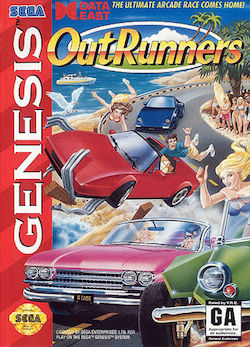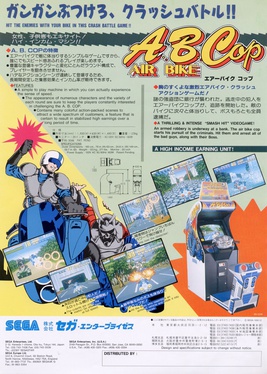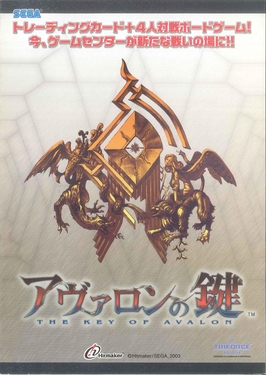
Virtua Fighter is a fighting game created for the Sega Model 1 arcade platform by AM2, a development group within Sega, headed by Yu Suzuki. An early prototype version was location tested in Japan by August 1993, before the complete game was released worldwide in December 1993. It is the first game in the Virtua Fighter series, and the first arcade fighting game to feature fully 3D polygon graphics. The game has been ported to several platforms including the Sega Saturn, Sega 32X, and Microsoft Windows.

Yu Suzuki is a Japanese game designer, producer, programmer, and engineer, who headed Sega's AM2 team for 18 years. Considered one of the first auteurs of video games, he has been responsible for a number of Sega's arcade hits, including three-dimensional sprite-scaling games that used "taikan" motion simulator arcade cabinets, such as Hang-On, Space Harrier, Out Run and After Burner, and pioneering polygonal 3D games such as Virtua Racing and Virtua Fighter, which are some of the games besides others from rival companies during that era credited with popularizing 3D graphics in video games; as well as the critically acclaimed Shenmue series. As a hardware engineer, he led the development of various arcade system boards, including the Sega Space Harrier, Model 1, Model 2 and Model 3, and was involved in the technical development of the Dreamcast console and its corresponding NAOMI arcade hardware.

Death Crimson OX is a light gun shooting game developed by Ecole Software. It was released in arcades in 2000 then ported to the Dreamcast console in 2001, several months after Sega had dropped support for the console. It is the third game in the Death Crimson series, and the only one to be released outside Japan. The game was also released as Guncom 2 in Europe and Death Crimson OX+ in Japan on the PlayStation 2.

Sega AM Research & Development No. 3, known as Hitmaker Co., Ltd. from 2000 to 2004, is a defunct division of Sega, a Japanese video game company. Established by 1993, AM3 was managed by Hisao Oguchi and developed a number of arcade games for Sega. Series introduced by AM3 include Virtual On, Sega Rally, Crazy Taxi, and Virtua Tennis. AM3's main focus was on arcade games until the release of the Dreamcast. Additionally, developers Tetsuya Mizuguchi and Kenji Sasaki developed Sega Rally Championship with AM3 before departing to form AM Annex, which later split into Sega AM9 and Sega AM5.

Sega AM Research & Development No. 2, previously known as SEGA-AM2 Co., Ltd., is a video game development team within the Japanese multinational video game developer Sega. Yu Suzuki, who had previously developed arcade games for Sega including Hang-On and Out Run, was the first manager of the department.

Virtua Fighter 2 is a 1994 fighting video game developed by Sega. It is the sequel to Virtua Fighter (1993), and the second game in the Virtua Fighter series. It was created by Sega's Yu Suzuki-headed AM2 and was released for arcades in 1994. Ports were released for the Sega Saturn in 1995 and Microsoft Windows in 1997.

OutRunners is a racing video game developed by Sega AM1 and released in Japan, Europe, and North America in 1993. It constitutes the third release in the arcade OutRun series and was ported to the Mega Drive in 1994.

Derby Owners Club is a horse racing arcade game developed by Sega AM3 and published by Sega. Players are put into the roles of breeder, trainer, jockey, and owner of a thoroughbred racehorse. Statistics are saved on a IC card that can be put into any machine. The first version was released in Japan in 1999 and ran on the NAOMI arcade board.
Virtua Fighter is a series of fighting games created by Sega AM2 and designer Yu Suzuki. The original Virtua Fighter was released in December 1993 and has received four main sequels and several spin-offs. The highly influential first Virtua Fighter game is widely recognized as the first 3D fighting game released.

World Club Champion Football is a Japanese collectible card game and football/soccer sports arcade video game released by Sega. The game is officially abbreviated as WCCF. It is the first arcade game to combine trading cards with a video game, establishing a new genre of arcade game. The game was mostly released in Japan and has never received a port.

A.B. Cop is a futuristic 3D racing arcade game released by Sega in 1990. It never received any official port to home consoles.

Sangokushi Taisen is a hybrid physical and digital collectible card game for the arcade, on the Chihiro arcade board. It is a real-time strategy-based game set in the Three Kingdoms period of Chinese history and the 14th century Chinese novel Romance of the Three Kingdoms by Luo Guanzhong. It uses the same housing as World Club Champion Football, with a sensitive playing area that can detect the position of the physical cards. Over 500 million trading cards have been shipped. It is the sixth trading card arcade game by Sega, following World Club Champion Football,Mushiking: The King of Beetles, The Key of Avalon,Love and Berry: Dress up and Dance! and Quest of D.

This is a list of development studios owned by Sega, a Japanese video game developer and publisher based in Tokyo, Japan. Accompanied with the list is their history of game development. Also included are the companies that Sega has acquired over the years. For a full list of games developed and published by Sega, see List of Sega video games, List of Sega mobile games and List of Sega arcade games.

Sega Corporation is a Japanese multinational video game and entertainment company headquartered in Shinagawa, Tokyo. Its international branches, Sega of America and Sega Europe, are headquartered in Irvine, California, and London. Its division for the development of arcade games and home video games, Sega Games, has existed in its current state since 2020; from 2015 to that point, the two had made up separate entities known as Sega Games and Sega Interactive Co., Ltd. Sega is a subsidiary of Sega Sammy Holdings. From 1983 until 2001, Sega also developed video game consoles.

Sega Sports Research and Development or Sega Sports R&D was a development division of the Japanese video game company Sega. It was previously known as Smilebit, one of nine semi-autonomous studios which Sega established in 2000. Smilebit was previously known as R&D6 or AM6 which itself was mainly based on Sega PC. Smilebit was known for its sports simulation titles, as well as Jet Set Radio. When Sega started releasing games for other platforms, Smilebit began developing games for the Xbox, with Jet Set Radio Future, Panzer Dragoon Orta and GunValkyrie. Smilebit was led by Shun Arai as president and Takayuki Kawagoe as director. Kawagoe became president of Smilebit in 2003.

Ryu Ga Gotoku Studio is a video game developer housed within the Japanese video game company Sega as part of its Sega CS Research and Development No. 1 division. It is known for developing the games in the Like a Dragon series, which the studio is named after, since Yakuza 5.

Dragon Treasure is an arcade game developed by Overworks and published by Sega in 2003 for the Sega NAOMI arcade board for Japanese arcades. The game is a coin-pusher game combined with a role-playing game, and can be played by multiple people. Progress can be stored on an IC card and can be resumed on any machine, which was new for medal games in Japan at the time. It received two sequels with Dragon Treasure II in 2004 and Dragon Treasure III in 2005.

Sega Net Mahjong MJ is a mahjong arcade game developed by Sega AM2 and released by Sega. The first version for arcades was released in July 2002 for the Sega NAOMI 2 arcade system. It featured online features with ranking, customization and recording your play history, using the experience that AM2 had developed from Virtua Fighter 4 and VF.NET. It received numerous updates and sequels since then.

Avalon no Kagi, alternatively known as The Key of Avalon is an arcade game developed by Hitmaker and published by Sega on the Triforce arcade board. It is the third card arcade game by Sega, following World Club Champion Football and Mushiking: The King of Beetles. It is a combination of sugoroku style board game and combat trading card game. It was followed by a sequel called The Key of Avalon 2: Eutaxy Commandment which was updated as The Key of Avalon 2.5: War of the Key.


















